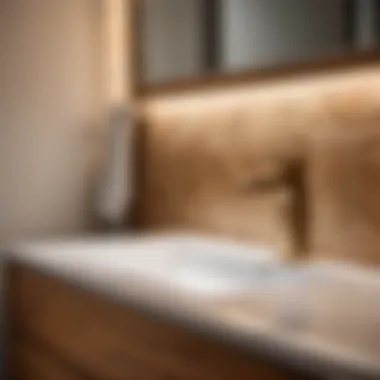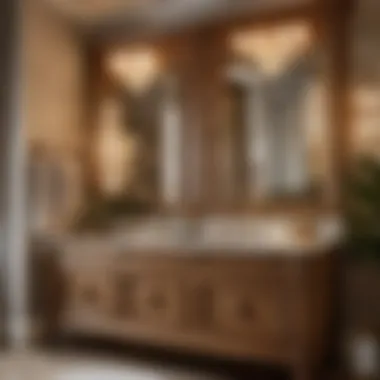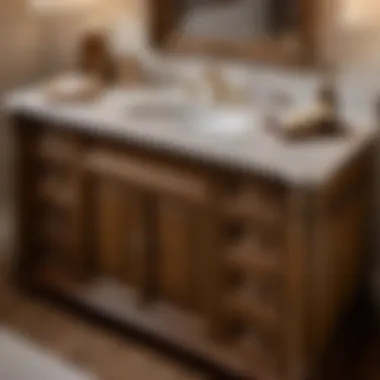Expert Guide: Transforming Oak Bathroom Vanity with Paint


Materials:
- Sandpaper (150, 220, and 400 grit)
- Tack cloth
- Primer suitable for oak surfaces
- High-quality paint (latex or oil-based)
- Paintbrushes (various sizes)
- Paint trays
- Painter's tape
- Drop cloths
- Fine-grit sanding sponge
- Clear polyurethane finish
- Rags
DIY Steps:
- Preparation: Begin by sanding the oak vanity with 150 grit sandpaper to remove the existing finish. Use tack cloth to clean off dust. Apply primer evenly on all surfaces.
- Painting Process: Use high-quality paint suitable for oak. Apply multiple thin coats to achieve a smooth finish. Allow each coat to dry completely before applying the next.
- Detailing: Use smaller brushes for intricate details and corners. Remove painter's tape carefully to ensure clean lines. Use a sanding sponge for any rough edges.
- Finishing Touches: Once the paint is dry, apply a clear polyurethane finish for protection and durability. Allow the vanity to dry completely before use.
Technical Aspects:
- Timing: Allow ample time for each coat of paint to dry completely before proceeding to the next step. Follow manufacturer's instructions for drying times.
- Tools: Use high-quality brushes for a smooth finish. Ensure proper ventilation during painting process for optimal results.
DIY Project Process:
- Sequential Steps: Follow a systematic approach from surface preparation to final detailing. Take your time and ensure each step is completed thoroughly for a professional finish.
- Troubleshooting Tips: In case of drips or uneven application, lightly sand the affected area and redo the painting process. Maintain precision during detailing for a polished look.
Introduction
In the realm of home renovation projects, the bathroom often stands out as a focal point for transformation. The oak bathroom vanity, a sturdy but perhaps outdated piece, holds the potential for a remarkable metamorphosis through the art of painting. This comprehensive guide will delve into the intricate process of infusing new life into a tired vanity, offering readers a step-by-step journey towards a refreshed and personalized aesthetic.
The introduction sets the stage for a profound exploration of turning a mundane vanity into a statement piece within the bathroom space. Oak, known for its durability and timeless appeal, can be rejuvenated into a modern, elegant, or rustic look, depending on the chosen paint and technique. Understanding the essence of this introduction is paramount as it paves the way for a complete overhaul of the bathroom ambiance.
With a focus on meticulous preparation, thoughtful paint selection, precise application, and final finishing touches, this guide aims to empower housewives and homeowners to undertake a rewarding DIY project that adds value and beauty to their living environment. The benefits of this transformation extend beyond aesthetics, as it also serves as an expression of creativity and personalized style within the home.
Moreover, considerations such as durability, maintenance, and long-term care play a vital role in guiding readers towards making informed decisions throughout each stage of the painting process. By providing detailed insights and practical advice, this introduction sets the tone for an immersive journey that culminates in a satisfaction of enjoying the visually stunning results of a meticulously painted oak bathroom vanity.
Preparing the Oak Vanity
When it comes to transforming an oak bathroom vanity with paint, the preparation stage is crucial in ensuring a successful outcome. Preparing the oak vanity sets the foundation for the painting process, allowing for better adhesion of the paint and ensuring a professional-looking finish. By following a few essential steps, you can enhance the durability and aesthetic appeal of your oak vanity.


To start the preparation process, begin by thoroughly cleaning and sanding the surface. Cleaning the vanity removes any dirt, grime, or residues that may hinder paint adhesion. Additionally, sanding the surface helps create a smooth base for the primer and paint layers, leading to a more polished final result.
Primarily, preparing the oak vanity contributes to the longevity of the painted finish. Properly prepped surfaces are less likely to experience chipping or peeling, ensuring that your newly painted vanity maintains its beauty for an extended period. Moreover, a well-prepared surface allows for better paint adhesion, preventing issues such as bubbling or flaking over time.
Considerations about preparing the oak vanity include selecting high-quality cleaning supplies that are suitable for wood surfaces. It's essential to choose products that effectively remove grime without damaging the wood. Additionally, using the right sanding tools and techniques is crucial in achieving a smooth and even surface, ready for painting.
Overall, preparing the oak vanity is a fundamental step in the painting process that should not be overlooked. By investing time and effort into thorough preparation, you can guarantee a stunning transformation of your bathroom vanity.
Cleaning and Sanding
Cleaning and sanding are essential components of preparing an oak vanity for painting. Both processes play a key role in ensuring that the surface is clean, smooth, and ready to receive the primer and paint layers.
Gather necessary cleaning supplies
When it comes to gathering necessary cleaning supplies, it is important to choose products specifically designed for cleaning wood surfaces. Avoid harsh chemicals that can damage the wood and opt for gentle yet effective cleaners. Microfiber cloths, wood-safe cleaning solutions, and a soft brush or sponge are essential supplies for this task.
Using the right cleaning products ensures that you remove dirt and grime without leaving behind residues that may interfere with the paint adhesion. Additionally, avoiding abrasive materials or cleaners prevents scratches or damage to the wood surface, preserving its quality for painting.
Remove hardware and drawers
Removing hardware and drawers from the vanity before cleaning and sanding is crucial to ensure thorough and precise preparation. By taking these components off, you can access hard-to-reach areas and corners, allowing for comprehensive cleaning and sanding.
This step also enables you to work on individual pieces separately, ensuring that each part is thoroughly cleaned and sanded before the painting process. Removing hardware and drawers facilitates a smoother painting experience and enhances the overall quality of the final finish.
Sand the surface to create a smooth base
Sanding the surface of the oak vanity is vital in creating a smooth and even base for the primer and paint. Use fine-grit sandpaper to gently sand the surface, focusing on areas with imperfections or roughness. This process helps to remove existing finishes, smooth out the wood, and promote better adhesion of the paint layers.
By creating a uniformly smooth base, you ensure that the subsequent layers of primer and paint adhere properly to the surface. Sanding also helps to improve the overall look of the vanity by eliminating any imperfections or inconsistencies, resulting in a professional and polished finish. Prioritize thorough sanding to achieve optimal results during the painting process.
Choosing the Right Paint


Selecting the right paint for transforming an oak bathroom vanity is a critical aspect of the entire process. The choice of paint can significantly impact the final look and durability of the project. When considering the right paint, it is essential to evaluate both the type of paint and the suitable finish for the vanity.
Selecting Paint Type
When it comes to selecting the paint type for your oak bathroom vanity, one of the primary decisions to make is between latex and oil-based paint. Latex paint is known for its quick drying time, easy cleanup with water, and low volatile organic compounds (VOCs). On the other hand, oil-based paint typically offers a more durable finish, excellent adhesion, and resistance to stains. In this article, the choice between latex and oil-based paint heavily influences the outcome of your vanity's transformation. While latex paint is easier to work with and environmentally friendly, oil-based paint provides a robust finish that can withstand moisture and wear.
Choosing a Suitable Finish for the Vanity
The finish you select for your vanity plays a crucial role in its appearance and longevity. Whether you opt for a glossy, semi-gloss, satin, or matte finish, each has its unique characteristics. A glossy finish offers a shiny surface that reflects light and is easy to clean, making it a popular choice for bathrooms. On the other hand, a matte finish provides a non-reflective surface that can hide minor imperfections. In this guide, choosing a suitable finish for your oak vanity involves considering factors such as the desired sheen level, maintenance requirements, and overall aesthetic goals. While a glossy finish may enhance the elegance of your bathroom, a matte finish can create a more understated and sophisticated look.
Color Selection
Selecting the right color for your painted oak vanity is a pivotal step in the transformation process. The color you choose should complement the existing bathroom decor while adding a touch of personal style. Two key aspects to consider when selecting the color are evaluating the overall bathroom aesthetic and testing samples on a small area.
Evaluating the Overall Bathroom Aesthetic
Before finalizing a color for your vanity, it's essential to assess how it blends with the overall aesthetic of your bathroom. Consider factors such as the existing color scheme, lighting conditions, and desired atmosphere. In this article, evaluating the overall bathroom aesthetic guides your color selection to ensure harmony within the space. Whether you prefer a cohesive look that coordinates with the rest of the bathroom or a contrasting statement piece, understanding the aesthetic impact of your color choice is crucial.
Testing Samples on a Small Area
To ensure you've chosen the perfect color for your oak vanity, testing samples on a small area is imperative. Different lighting conditions can significantly alter the appearance of a color, so it's essential to see how it looks in your specific bathroom environment. In this guide, testing samples on a small area allows you to observe how the color interacts with the vanity's texture, the surrounding walls, and the overall ambiance. Whether you're leaning towards a subtle neutral tone or a vibrant pop of color, testing samples helps you make an informed decision that aligns with your vision for the space.
Painting the Oak Vanity
Painting the Oak Vanity is a pivotal stage in the transformation process outlined in this comprehensive guide. Adding a fresh coat of paint can breathe new life into your oak bathroom vanity, giving it a modern and updated look that enhances the overall aesthetic of your bathroom. The selection of the right paint color and type is crucial in achieving the desired outcome. By carefully considering factors such as the existing bathroom decor and personal preferences, you can create a cohesive and stylish finish that ties the room together.
Applying the Paint
When it comes to Applying the Paint, using a high-quality brush or roller is essential for achieving a smooth and professional finish. A high-quality brush ensures even application and helps in minimizing brush strokes, while a roller can provide a seamless coat of paint with minimal effort. This method allows for better control and precision, resulting in a more refined look that showcases the beauty of the oak vanity.
Creating a Distressed Look (Optional)


For those looking to add a vintage or antique touch to their vanity, Creating a Distressed Look can offer a unique and customized appearance. One approach is Sanding edges and corners to create a worn effect, adding character and depth to the piece. Additionally, Applying a dark glaze for an aged appearance can enhance the distressed look, giving the oak vanity a rich patina that exudes charm and sophistication. These techniques allow for personal creativity and can transform a standard oak vanity into a standout feature in your bathroom.
Finishing Touches
In the realm of transforming an oak bathroom vanity with paint, the finishing touches play a critical role in enhancing the entire aesthetic appeal of the project. The application of finishing touches marks the culmination of a meticulous process, ensuring that the painted oak vanity achieves a flawless, professional finish. Attention to detail in this phase can truly elevate the overall appearance of the vanity and make a significant impact on the entire bathroom space. Prospective home renovators and DIY enthusiasts are encouraged to approach this final stage with patience and precision, as it is the hallmark of a successfully completed project.
Sealing the Paint
Choosing a Durable Sealant
When it comes to choosing a durable sealant for your painted oak bathroom vanity, durability and longevity are the key factors to consider. Opting for a sealant with high durability not only protects the painted surface from moisture, stains, and wear but also ensures that the newly painted vanity maintains its luster for an extended period. A durable sealant acts as a shield, safeguarding the painted surface against everyday usage, making it a popular choice for individuals aiming to preserve the visual appeal of their vanity for years to come.
Applying Sealant Evenly
The meticulous application of sealant plays a crucial role in the longevity and effectiveness of the protective coating. By ensuring uniform coverage and smooth application, individuals can prevent uneven finishes or streaking, resulting in a flawless final appearance. Applying sealant evenly not only enhances the durability of the paint but also contributes to the overall aesthetic of the vanity, producing a professional-looking result that reflects careful craftsmanship.
Ensuring Ample Curing Time
One of the key considerations in the sealing process is allowing ample time for the sealant to cure effectively. Proper curing time ensures that the sealant bonds securely with the painted surface, enhancing its protective capabilities and resilience. Rushing this step could jeopardize the integrity of the sealant, leading to premature wear and diminished protection. Therefore, homeowners should exercise patience and follow manufacturer recommendations regarding curing time to achieve optimal results in sealing the painted oak vanity.
Maintenance Tips
Maintenance is a crucial aspect to consider when transforming an oak bathroom vanity with paint. It ensures the longevity and aesthetic appeal of the vanity over time, safeguarding the investment made in the painting process. By incorporating diligent maintenance practices, homeowners can enjoy a freshly painted vanity for years to come.
Caring for Your Painted Vanity
Regular cleaning to maintain finish
Regular cleaning plays a vital role in preserving the finish of a painted vanity. It involves using mild soaps or specialized cleaners to gently remove dust, dirt, and grime that may accumulate on the surface. Regular cleaning not only enhances the appearance of the vanity but also prevents the buildup of residue that can tarnish the paint. This maintenance practice is key to sustaining the vibrancy and sheen of the painted surface, ensuring a pristine look in the bathroom. Homeowners can benefit from the simplicity of regular cleaning routines, as they contribute significantly to the overall upkeep of the vanity.
Avoiding harsh chemicals
Avoiding harsh chemicals is imperative to maintaining the integrity of the painted surface. Harsh chemicals can strip away the paint layer, leading to premature wear and discoloration. By opting for gentle cleaning solutions and steering clear of abrasive agents, homeowners can safeguard the paint finish and prevent unnecessary damage. This cautious approach not only protects the aesthetic appeal of the vanity but also promotes a safe environment within the bathroom. Choosing mild alternatives over harsh chemicals is a prudent decision that aligns with the goal of long-lasting paint durability.
Touching up any chips or scratches
Touching up chips or scratches promptly is paramount in preserving the flawless appearance of a painted vanity. Minor damages such as chips or scratches can occur due to everyday use or accidental impacts. By addressing these issues in a timely manner, homeowners can prevent further deterioration of the paint and maintain the overall beauty of the vanity. Touch-up kits or matching paint colors can be used to seamlessly repair any imperfections, ensuring a seamless finish. This proactive approach to maintenance allows homeowners to tackle minor damages efficiently, sustaining the visual appeal and quality of the painted oak vanity.







